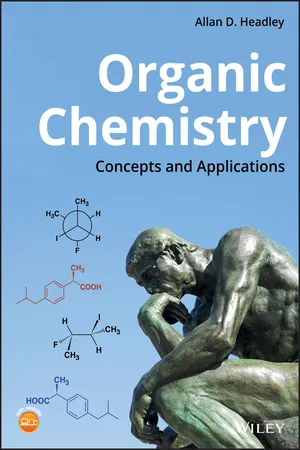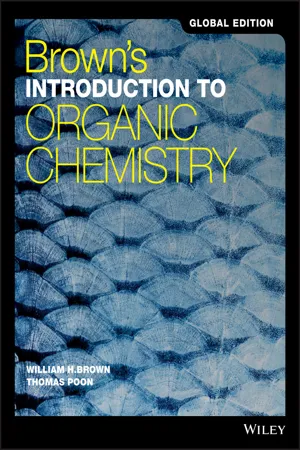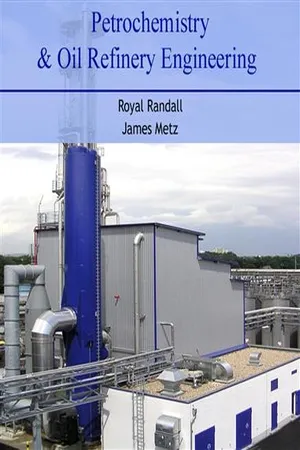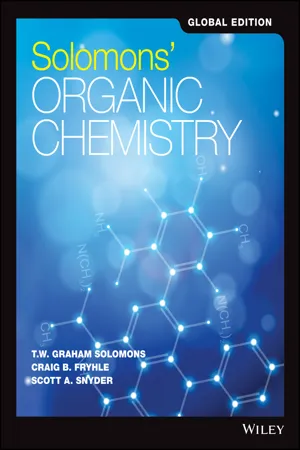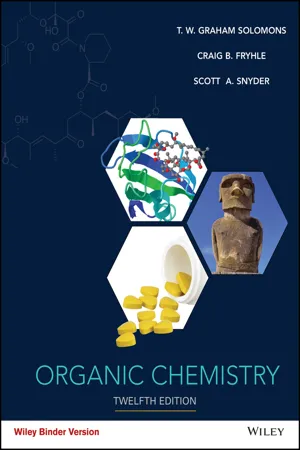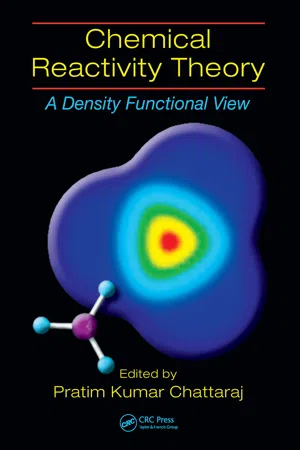Chemistry
Chemical Properties of Benzene
Benzene exhibits several important chemical properties, including its stability due to the delocalization of electrons in its aromatic ring. It undergoes substitution reactions rather than addition reactions due to its aromatic nature. Benzene also participates in electrophilic aromatic substitution reactions, where an electrophile replaces a hydrogen atom on the benzene ring.
Written by Perlego with AI-assistance
Related key terms
1 of 5
10 Key excerpts on "Chemical Properties of Benzene"
- eBook - ePub
Organic Chemistry
Concepts and Applications
- Allan D. Headley(Author)
- 2019(Publication Date)
- Wiley(Publisher)
Benzene is another one of these organic compounds with a very distinctive aroma and is responsible for the odor of coal distillate. It was discovered that these organic compounds all have a special feature, which is described as aromaticity, and as result, these compounds are referred to as aromatic compounds. As you can imagine, there are numerous compounds that can be described as aromatic compounds. There are other aromatic compounds that may not have a distinct characteristic odor. Some include aspirin, morphine, norepinephrine, epinephrine, nicotine, vitamin E, and estrone. It is difficult to study all aromatic compounds individually, so we will carry out our study of aromatic compounds on the most common aromatic compound, benzene, and apply the knowledge gained to other compounds that are similar and aromatic.Benzene was isolated from compressed illuminating gas in 1825 by Michael Faraday of the Royal Institution. In 1834, Eilhardt Mitscherlich of the University of Berlin synthesized benzene by heating benzoic acid with calcium oxide and he also showed that the molecular formula of benzene is C6 H6 . Today, benzene is obtained primarily from the distillation of petroleum, and it is used in the synthesis of many useful chemicals in our society. Benzene is also a very common solvent that is used in most chemical labs, both industrial and academic. However, it was removed from teaching labs, since it was shown to cause cancer when given to laboratory animals in very large dosage. Benzene is absorbed in the blood stream from inhalation and is converted to phenols and excreted by the liver. Benzene causes skin irritation; it is thought to cause leukemia. If absorbed in the blood, it will increase the number of white blood cells and it also causes damage to bone marrow. However, it is still sometimes used, under very controlled conditions, in industrial and research labs.Since most of the chemical properties of compounds in this very large category of aromatic compounds are similar, we will study in detail the chemistry of only one of these compounds, benzene. By knowing the chemical and physical properties of benzene, we will be able to predict the properties of other aromatic compounds. In this chapter, we will first define aromaticity in a chemical sense and then apply that definition to other molecules to determine if they are aromatic or not. In the later sections of the chapter, we will examine the reactions of aromatic compounds.17.2 Structure and Properties of Benzene
It was shown that the chemical formula of benzene is C6 H6 . Based on our knowledge of the number of hydrogens that are bonded to the carbons of saturated hydrocarbons, it is obvious that benzene is not a saturated hydrocarbon. In 1866, Friedrich Kekulé proposed that benzene had a cyclic structure with three alternating double bonds, as shown in Figure 17.1 - eBook - ePub
- James G. Speight(Author)
- 2019(Publication Date)
- Gulf Professional Publishing(Publisher)
Aromatic hydrocarbon derivatives are derived from benzene. Group members have six free valence electrons which are distributed in a circle in the form of a charged cloud. Because of the presence of these valence electrons, we can predict that the reactivity of these aromatic compounds will be similar to other unsaturated hydrocarbon derivatives. However, benzene is much less reactive than other unsaturated hydrocarbon derivatives. Only at high temperatures and in the presence of a catalyst can benzene take on another hydrogen atom. When it does, cyclohexane is the resultant product.5. Physical properties
Physical properties can be observed or measured without changing the composition of matter. Physical properties are used to observe and describe matter (Howard and Meylan, 1997 ; Yaws, 1999 ). The three states of matter are: solid, liquid, and gas. The melting point and boiling point are related to changes of the state of matter. All matter may exist in any of three physical states of matter. A physical change takes place without any changes in molecular composition. The same element or compound is present before and after the change. The same molecule is present throughout the changes. Physical changes are related to physical properties since some changes require a change in the three-dimensional structure of the molecule.Physical properties that are of interest in the current context include: (i) boiling point, (ii) density and specific gravity, (iii) dew point, (iv) flash point and ignition temperature, (v) melting point, and (vi) vapor density. These properties are listed in alphabetical order rather than attempt to assign importance to any individual property. The properties present indications the behavior of hydrocarbon derives as determined by application of standard test method (Speight, 2015 ).The physical properties of alkene derivatives are similar to those of the alkane derivatives. The boiling points of straight-chain alkenes increase with increasing molar mass, just as with alkanes. For molecules with the same number of carbon atoms and the same general shape, the boiling points usually differ only slightly, just as would be expected for chemicals in which whose molar mass differs by only one to two hydrogen atoms (i.e., RCH2 CHCH2 compared to RCH2 CH2 CH3 - eBook - PDF
Foundations of Chemistry
An Introductory Course for Science Students
- Philippa B. Cranwell, Elizabeth M. Page(Authors)
- 2021(Publication Date)
- Wiley(Publisher)
15 The chemistry of aromatic compounds At the end of this chapter, students should be able to: • Understand the structure of benzene and other aromatic compounds • Be able to describe and explain electrophilic aromatic substitution, S E Ar • Determine if a ring substituent is activating or deactivating • Compare and contrast the reactivity of benzene, phenol, and aniline with electrophiles 15.1 Benzene 15.1.1 The structure of benzene Benzene , C 6 H 6 , is a molecule that can be described as aromatic . This is because when benzene and benzene-containing compounds were first isolated, they were noted to smell pleasant, so their name was derived from the Greek ‘ aroma ’ , meaning spice, which was then used in Latin to mean ‘ sweet smell ’ . Benzene is a simple aromatic compound that is often studied in undergraduate courses. It is a colourless liquid with a slightly sweet odour and is fully aromatic. Benzene can be represented in a number of ways depending upon what information needs to be depicted (Figure 15.1). Each carbon atom in the benzene molecule is trigonal planar in geometry, with a bond angle of 120 between the other two carbon atoms and the hydro-gen. In terms of the bonding, there are three σ bonds and one π bond per carbon atom. The π bond is formed by an electron in the p orbital of one carbon atom overlapping with an electron in a p orbital on an adjacent carbon atom. This overlap causes a cyclic system of bonding p orbitals (or π bonds) to be formed, where the electrons are free to move around the ring. The movement of electrons in this manner is called delocalisation , and benzene can be said to have a delocalised electron system above and below the ring . Benzene has a delocalised electron system above and below the ring. For a refresher on the shapes of molecules, please see Chapter 2. Foundations of Chemistry: An Introductory Course for Science Students , First Edition. Philippa B. Cranwell and Elizabeth M. Page. © 2021 John Wiley & Sons Ltd. - eBook - PDF
- William H. Brown, Thomas Poon(Authors)
- 2017(Publication Date)
- Wiley(Publisher)
As it is now used, the term aromatic refers instead to the fact that benzene and its derivatives are highly unsaturated compounds that are unexpectedly stable toward reagents that react with alkenes. Aromatic compound A term used to classify benzene and its derivatives. 9 Benzene and Its Derivatives K E Y Q U E S T I O N S 9.1 What Is the Structure of Benzene? 9.2 What Is Aromaticity? 9.3 How Are Benzene Compounds Named, and What Are Their Physical Properties? 9.4 What Is the Benzylic Position, and How Does It Contribute to Benzene Reactivity? 9.5 What Is Electrophilic Aromatic Substitution? 9.6 What Is the Mechanism of Electrophilic Aromatic Substitution? 9.7 How Do Existing Substituents on Benzene Affect Electrophilic Aromatic Substitution? 9.8 What Are Phenols? H O W TO 9.1 How to Determine Whether a Lone Pair of Electrons Is or Is Not Part of an Aromatic Pi System 9.2 How to Determine Whether a Substituent on Benzene Is Electron Withdrawing C H E M I C A L C O N N E C T I O N S 9A Carcinogenic Polynuclear Aromatics and Cancer 9B Capsaicin, for Those Who Like It Hot Courtesy Douglas Brown Peppers of the capsicum family. Hot peppers contain significant amounts of the chemical capsaicin, which is used for medicinal purposes as well as for tantalizing taste buds (see Chemical Connections, “Capsaicin, for Those Who Like It Hot”). Inset: A model of capsaicin. 9 . 1 What Is the Structure of Benzene? 267 We use the term arene to describe aromatic hydrocarbons, by analogy with alkane and alkene. Benzene is the parent arene. Just as we call a group derived by the removal of an H from an alkane an alkyl group and give it the symbol R , we call a group derived by the removal of an H from an arene an aryl group and give it the symbol Ar . 9.1 What Is the Structure of Benzene? Let us imagine ourselves in the mid‐nineteenth century and examine the evidence on which chemists attempted to build a model for the structure of benzene. - eBook - ePub
Understanding Advanced Organic and Analytical Chemistry
The Learner's ApproachRevised Edition
- Kim Seng Chan, Jeanne Tan;;;(Authors)
- 2016(Publication Date)
- WS EDUCATION(Publisher)
As with the trend for homologues of each homologous series, the melting and boiling points of arenes increase with the increase in molecular mass. This is because an increase in molecular mass is associated with an increase in the number of atoms in the molecule, thus resulting in an increase in the total number of electrons. The greater number of electrons contributes to a more polarizable electron cloud, leading to stronger id–id interactions. The boiling point of benzene is about 80° C.6.3.2 Solubility
As with all hydrocarbons, arenes are soluble in non-polar organic solvents and insoluble in polar solvents. Benzene used to be an excellent solvent for organic compounds, but things have changed since it was found that benzene is toxic and carcinogenic. With similar solvent properties and being less toxic, methylbenzene has replaced benzene as a common solvent in the laboratory.6.4 Chemical Properties of Benzene
In order to “retain” the added stability brought about by the delocalization of pi electrons over the network of six carbon atoms, benzene undergoes mostly substitution reactions, in contrast with an alkene molecule. As the more “loosely” bounded pi electrons are available, benzene is an attractive site for strong electrophiles to attack. Benzene does not behave chemically the same as alkenes. This difference is clearly seen in their behavior towards the same reagents:• When Br2 in CCl4 is added separately to cyclohexene and benzene, there is instant decolorization of reddish-brown Br2 observed when it is mixed with cyclohexene. No decolorization of Br2 is observed when mixed with benzene.• When cold alkaline KMnO4 (aq) is added separately to both hydrocarbons, decolorization of purple KMnO4 (aq) and a brown precipitate of MnO2 (s) will be observed for cyclohexene but not benzene.Benzene does undergo addition reactions only when reaction conditions are harsh enough. For instance, it can undergo hydrogenation, using a nickel catalyst, and be converted to cyclohexane. But this reaction requires a much higher temperature (150–250° C) and pressure (25 atm) compared to the hydrogenation of cyclohexene. - No longer available |Learn more
- (Author)
- 2014(Publication Date)
- Academic Studio(Publisher)
To reflect the delocalized nature of the bonding, benzene is often depicted with a circle inside a hexagonal arrangement of carbon atoms: The delocalized picture of benzene has been contested by Cooper, Gerratt and Raimondi in their article published in 1986 in the journal Nature. They showed that the electrons in benzene are almost certainly localized, and the aromatic properties of benzene originate from spin coupling rather than electron delocalization. This view has been supported in the next-year Nature issue, but it has been slow to permeate the general chemistry community. As is common in organic chemistry, the carbon atoms in the diagram above have been left unlabeled. Realizing each carbon has 2p electrons, each carbon donates an electron into the delocalized ring above and below the benzene ring. It is the side-on overlap of p-orbitals that produces the pi clouds. ________________________ WORLD TECHNOLOGIES ________________________ Benzene occurs sufficiently often as a component of organic molecules that there is a Unicode symbol in the Miscellaneous Technical block with the code U+232C ( ⌬ ) to represent it with three double bonds, and U+23E3 for a delocalized version. Substituted benzene derivatives Many important chemicals are derived from benzene by replacing one or more of its hydrogen atoms with another functional group. Examples of simple benzene derivatives are phenol, toluene, and aniline, abbreviated PhOH, PhMe, and PhNH 2 , respectively. Linking benzene rings gives biphenyl, C 6 H 5 –C 6 H 5 . Further loss of hydrogen gives fused aromatic hydrocarbons, such as naphthalene and anthracene. The limit of the fusion process is the hydrogen-free allotrope of carbon, graphite. In heterocycles, carbon atoms in the benzene ring are replaced with other elements. The most important derivatives are the rings containing nitrogen. Replacing one CH with N gives the compound pyridine, C 5 H 5 N. - eBook - PDF
- T. W. Graham Solomons, Craig B. Fryhle, Scott A. Snyder(Authors)
- 2017(Publication Date)
- Wiley(Publisher)
14.1 THE DISCOVERY OF BENZENE The following are a few examples of aromatic compounds, including benzene itself. In these formulas we foreshadow our discussion of the special properties of the benzene ring by using a circle in a hexagon to depict the six π electrons and six-membered ring of these compounds, whereas up to now we have shown benzene rings only as indicated in the left-hand formula for benzene below. The study of the class of compounds that organic chemists call aromatic compounds (Section 2.1D) began with the discovery in 1825 of a new hydrocarbon by the English chemist Michael Faraday (Royal Institution). Faraday called this new hydrocarbon “bicar- buret of hydrogen”; we now call it benzene. Faraday isolated benzene from a compressed illuminating gas that had been made by pyrolyzing whale oil. In 1834 the German chemist Eilhardt Mitscherlich (University of Berlin) synthesized benzene by heating benzoic acid with calcium oxide. Using vapor density measurements, Mitscherlich further showed that benzene has the molecular formula C 6 H 6 : C 6 H 5 CO 2 H + CaO → heat C 6 H 6 + CaCO 3 Benzoic acid Benzene The molecular formula itself was surprising. Benzene has only as many hydrogen atoms as it has carbon atoms. Most compounds that were known then had a far greater propor- tion of hydrogen atoms, usually twice as many. Benzene, having the formula of C 6 H 6 , should be a highly unsaturated compound because it has an index of hydrogen deficiency equal to 4. Eventually, chemists began to recognize that benzene was a member of a new class of organic compounds with unusual and interesting properties. As we shall see in Section 14.3, benzene does not show the behavior expected of a highly unsaturated compound. During the latter part of the nineteenth century the Kekulé–Couper–Butlerov theory of valence was systematically applied to all known organic compounds. - eBook - ePub
- James G. Speight(Author)
- 2010(Publication Date)
- Gulf Professional Publishing(Publisher)
cyclic alkanes) are differentiated from aliphatic hydrocarbons insofar as they contain a ring structure and form a homologous group of compounds. The first member of the series is cyclopentane followed by cyclohexane. Cycloalkanes are saturated compounds and, like linear alkanes, are not very reactive.Aromatic hydrocarbons are derived from benzene. Group members have six free valence electrons which are distributed in a circle in the form of a charged cloud. Because of the presence of these valence electrons, we can predict that the reactivity of these aromatic compounds will be similar to other unsaturated hydrocarbons. However, benzene is much less reactive than other unsaturated hydrocarbons. Only at high temperatures and in the presence of a catalyst can benzene take on another hydrogen atom. When it does, cyclohexane is the resultant product.5. Physical propertiesPhysical properties can be observed or measured without changing the composition of matter. Physical properties are used to observe and describe matter (Howard and Meylan, 1997 and Yaws, 1999 ). The three states of matter are: solid, liquid, and gas. The melting point and boiling point are related to changes of the state of matter. All matter may exist in any of three physical states of matter.A physical change takes place without any changes in molecular composition. The same element or compound is present before and after the change. The same molecule is present throughout the changes. Physical changes are related to physical properties since some measurements require that changes be made.Physical properties that are of interest in the current context include: boiling point, melting point, density, vapor density, flash point, ignition temperature, and dew point.5.1. Boiling points and melting pointsThe boiling point of an organic compound is the temperature at which the vapor pressure of the liquid equals the environmental pressure surrounding the liquid.The melting point - eBook - PDF
- T. W. Graham Solomons, Craig B. Fryhle, Scott A. Snyder(Authors)
- 2016(Publication Date)
- Wiley(Publisher)
See for additional examples, videos, and practice. 14.1 THE DISCOVERY OF BENZENE The following are a few examples of aromatic compounds, including benzene itself. In these formulas we foreshadow our discussion of the special properties of the benzene ring by using a circle in a hexagon to depict the six π electrons and six-membered ring of these compounds, whereas up to now we have shown benzene rings only as indicated in the left-hand formula for benzene below. Methyl salicylate (in oil of wintergreen) OH OCH 3 O Benzaldehyde (in oil of almonds) H O Benzene or Eugenol (in oil of cloves) HO OCH 3 Cinnamaldehyde (in oil of cinnamon) H O Vanillin (in oil of vanilla) OCH 3 H HO O Acetylsalicylic acid (aspirin) OH O O O The study of the class of compounds that organic chemists call aromatic compounds (Section 2.1D) began with the discovery in 1825 of a new hydrocarbon by the English chemist Michael Faraday (Royal Institution). Faraday called this new hydrocarbon “bicar- buret of hydrogen”; we now call it benzene. Faraday isolated benzene from a compressed illuminating gas that had been made by pyrolyzing whale oil. In 1834 the German chemist Eilhardt Mitscherlich (University of Berlin) synthesized benzene by heating benzoic acid with calcium oxide. Using vapor density measurements, Mitscherlich further showed that benzene has the molecular formula C 6 H 6 : C 6 H 5 CO 2 H + CaO → heat C 6 H 6 + CaCO 3 Benzoic acid Benzene The molecular formula itself was surprising. Benzene has only as many hydrogen atoms as it has carbon atoms. Most compounds that were known then had a far greater propor- tion of hydrogen atoms, usually twice as many. Benzene, having the formula of C 6 H 6 , should be a highly unsaturated compound because it has an index of hydrogen deficiency equal to 4. Eventually, chemists began to recognize that benzene was a member of a new class of organic compounds with unusual and interesting properties. - eBook - PDF
Chemical Reactivity Theory
A Density Functional View
- Pratim Kumar Chattaraj(Author)
- 2009(Publication Date)
- CRC Press(Publisher)
28 Aromaticity and Chemical Reactivity Eduard Matito, Jordi Poater, Miquel Solà, and Paul von Ragué Schleyer CONTENTS 28.1 Introduction .............................................................................................. 419 28.2 Measures of Aromaticity .......................................................................... 422 28.3 Aromaticity and Stability ......................................................................... 424 28.4 Chemical Reactions In fl uenced by Changes in Aromaticity ................... 425 28.4.1 Conjugated Hydrocarbons ........................................................... 425 28.4.1.1 Acenes ......................................................................... 425 28.4.1.2 Pericyclic Reactions .................................................... 427 28.4.1.3 Pseudopericyclic Reactions ......................................... 430 28.4.2 Inorganic and Organometallic Compounds ................................ 432 28.4.2.1 Reactivity of All-Metal Aromatic Species .................. 432 28.4.2.2 Reactions Involving Metallabenzenes ......................... 433 28.4.2.3 Haptotropic Changes ................................................... 433 28.4.2.4 Guanine – Cytosine Base-Pair Interacting with Metal Cations ...................................................... 434 28.5 Conclusions .............................................................................................. 434 References ............................................................................................................. 435 28.1 INTRODUCTION Michael Faraday ’ s seminal 1825 paper, reporting the isolation of benzene (dicarburet of hydrogen) by distillation, noted that it was much less reactive than ‘‘ monocarburet of hydrogen ’’ ( trans -2-butene) [1]. Such decreased reactivity has been taken as an experimental characteristic of aromaticity ever since.
Index pages curate the most relevant extracts from our library of academic textbooks. They’ve been created using an in-house natural language model (NLM), each adding context and meaning to key research topics.
